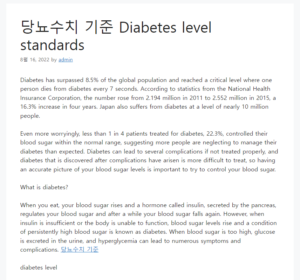Diabetes has surpassed 8.5% of the global population and reached a critical level where one person dies from diabetes every 7 seconds. According to statistics from the National Health Insurance Corporation, the number rose from 2.194 million in 2011 to 2.552 million in 2015, a 16.3% increase in four years. Japan also suffers from diabetes at a level of nearly 10 million people.
Even more worryingly, less than 1 in 4 patients treated for diabetes, 22.3%, controlled their blood sugar within the normal range, suggesting more people are neglecting to manage their diabetes than expected. Diabetes can lead to several complications if not treated properly, and diabetes that is discovered after complications have arisen is more difficult to treat, so having an accurate picture of your blood sugar levels is important to try to control your blood sugar.
What is diabetes?
When you eat, your blood sugar rises and a hormone called insulin, secreted by the pancreas, regulates your blood sugar and after a while your blood sugar falls again. However, when insulin is insufficient or the body is unable to function, blood sugar levels rise and a condition of persistently high blood sugar is known as diabetes. When blood sugar is too high, glucose is excreted in the urine, and hyperglycemia can lead to numerous symptoms and complications. 당뇨수치 기준
diabetes level
Blood sugar is the concentration of glucose per 100 ml of blood. Usually 100 ml has a concentration of 80 to 100 mg. Blood sugar falls when starving and rises slightly to around 120 to 130 mg after a meal. After fasting for 8 hours or more, measured fasting blood glucose should not exceed 100 mg/dL, and diabetes is diagnosed when fasting blood glucose exceeds 126 mg/dL. In addition, regardless of the presence or absence of meals, if the measured blood glucose is hyperglycemia greater than 200 mg/dl at any time or if hyperglycemia is indicated and symptoms consistent with diabetes are present (polyuria, then unexplained weight loss) , Diagnose Diabetes . Diabetes is difficult to diagnose with just one blood glucose test, so tests may be repeated and additional tests may be needed. nicetomeetya
*Other blood glucose standards

– Oral glucose tolerance test: After the fasting blood glucose test, drink 75g of glucose dissolved in 300ml of water, measure at 30-minute intervals, and if the blood glucose is over 200mg/dL after 2 hours, it is diagnosed with diabetes.
– Glycation hemoglobin test: reflects the average blood sugar level for 2-3 months, but can be measured at any time before or after meals. A normal level of glycated hemoglobin is 5.6% or less, and when it is 6.5% or more, diabetes is diagnosed.
What are the risk factors that cause diabetes?
How to lower diabetes levels
Because blood sugar is affected by the state of the body, food intake, and amount of exercise, lifestyle changes such as weight loss and exercise are the main ways to lower blood sugar. In addition, when it is difficult to improve only through lifestyle habits, drug treatment can be started on the basis of medical assessment after consulting a doctor.
01. Improving lifestyle habits
– Maintaining the right weight: Obesity is a factor that increases blood pressure, blood sugar and blood lipids. Belly fat in particular is more dangerous than fat elsewhere, so reducing waist size is also important.
– Dietary habits: in the case of diabetes, the diet must be balanced with the minimum required calories. Most of the foods that are good for diabetes are vegetables, and it’s recommended that you eat raw, boiled, or grilled recipes instead of fried or fried recipes so you can get fiber from vegetables and fruits.
– Exercise: Aerobic exercises such as walking, swimming, jogging, cycling and mountain climbing are good. Regular exercise can help with weight loss, and exercise helps prevent hyperglycemia by using sugar left in the blood as energy when your muscles contract.
02. Drug treatment and regular check-ups
When it is difficult to control blood sugar by improving lifestyle habits such as eating habits and exercise, drug treatment can be given based on a specialist’s medical judgment. But even if you take medication, diet and exercise therapy must be carried out together. You should also pay attention to changing blood sugar levels and the development of complications through regular check-ups.
*If a patient already has diabetes, 80 to 120 mg/dL is best. If it’s below, hypoglycemic symptoms can occur, and if it’s high, it can cause complications. Blood glucose levels should be controlled by screening. With type 2 diabetes, complications are already known in more than 5% to 10% of patients at the time of diagnosis, it is recommended to check the presence or absence of complications individually.
If you have hyperlipidemia, high blood pressure, or diabetes, you need a cardiovascular test ☞ click
Chest comfort internal medicine diabetes treatment
Cardiovascular disease is known to be the cause of diabetes complications and most deaths. Diabetes should be treated as a cardiovascular disease.
In cardiology, we are not only interested in diabetes, but also in metabolic syndrome, which is a prediabetic stage, from the perspective of cardiovascular disease, and we strive to prevent cardiovascular disease through diagnosis and treatment and to treat. You will also receive a detailed check-up to prevent complications from diabetes.